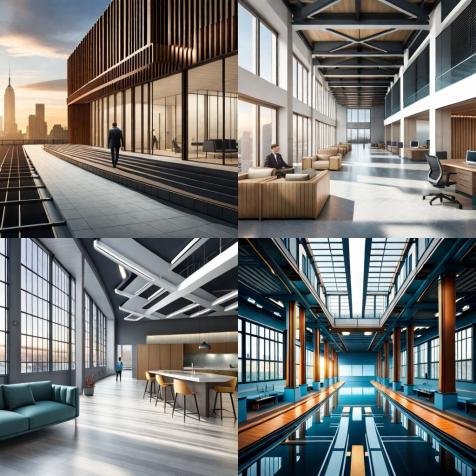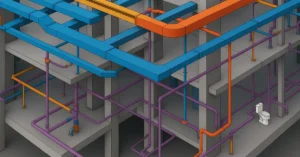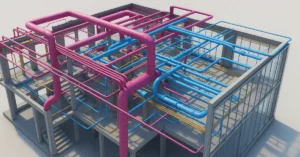In recent years, Building Information Modeling (BIM) and Artificial Intelligence (AI) have transformed the construction industry by enhancing design, reducing construction errors, and improving project efficiency. However, their potential applications are not limited to the construction phase. BIM and AI can also revolutionize facility management by optimizing maintenance, reducing costs, and improving building performance. In this blog, we will explore the possibilities of BIM and AI in facility management and their benefits.
Facility management is the process of managing and maintaining buildings, infrastructure, and facilities to ensure optimal functionality, safety, and performance. This involves several activities such as maintenance, repair, space management, security, and energy management. Facility managers are responsible for ensuring that buildings are safe, functional, and efficient, while minimizing costs and maximizing the building’s lifespan.
Building Information Modeling (BIM) is a digital representation of a building’s physical and functional characteristics. It enables architects, engineers, and contractors to collaborate on a project by creating a virtual 3D model that includes all building components, such as walls, floors, ceilings, and mechanical, electrical, and plumbing systems. BIM also provides information about the building’s performance, such as energy consumption, acoustics, and thermal comfort.
Artificial Intelligence (AI) is a technology that enables machines to learn from data, patterns, and experiences. AI algorithms can analyze and interpret complex data sets to identify patterns, predict outcomes, and make decisions. AI can also automate routine tasks, such as data entry, scheduling, and maintenance, freeing up time for facility managers to focus on strategic tasks.

Now, let’s explore the potential applications of BIM and AI in facility management.
- Maintenance Optimization
Facility managers spend a significant amount of time and resources on maintenance activities such as inspections, repairs, and replacements. BIM and AI can optimize maintenance by predicting equipment failures, identifying maintenance needs, and scheduling preventive maintenance. For example, AI algorithms can analyze data from sensors and equipment to detect anomalies and predict when maintenance is needed. This can reduce downtime, extend equipment lifespan, and prevent costly breakdowns.
- Cost Optimization
Facility managers are constantly looking for ways to reduce costs without compromising quality or safety. BIM and AI can help optimize costs by identifying inefficiencies, reducing energy consumption, and optimizing space utilization. For example, BIM can simulate different scenarios and layouts to identify the most efficient use of space and resources. AI algorithms can also analyze data from building systems to optimize energy consumption and reduce utility bills.
- Performance Improvement
Facility managers are responsible for ensuring that buildings are safe, functional, and comfortable for occupants. BIM and AI can improve building performance by analyzing data and identifying opportunities for improvement. For example, BIM can simulate different environmental conditions, such as temperature, humidity, and lighting, to optimize indoor air quality and thermal comfort. AI algorithms can also analyze data from occupancy sensors to adjust lighting, heating, and cooling systems to meet occupants’ needs.
- Safety Enhancement
Facility managers are responsible for ensuring that buildings meet safety standards and regulations. BIM and AI can enhance safety by identifying potential hazards, predicting risks, and providing real-time alerts. For example, BIM can simulate emergency scenarios, such as fires or earthquakes, to identify potential hazards and evacuation routes. AI algorithms can also analyze data from security systems to detect potential threats and provide real-time alerts to facility managers and security personnel.
Conclusion
In conclusion, BIM and AI have the potential to revolutionize facility management by optimizing maintenance, reducing costs, improving building performance, and enhancing safety. By leveraging BIM and AI, facility managers can make data-driven decisions that enhance the building’s functionality and reduce costs while providing a safe, comfortable, and healthy environment for occupants.
To fully realize the potential of BIM and AI in facility management, facility managers need to embrace new technologies and develop the skills required to use them effectively. This includes investing in training programs, data management systems, and collaboration tools that enable them to leverage the full potential of BIM and AI.
In summary, the integration of BIM and AI into facility management has the potential to unlock significant benefits for facility managers, building owners, and occupants alike. By embracing new technologies and leveraging data-driven insights, facility managers can optimize maintenance, reduce costs, and improve building performance and safety, ultimately enhancing the value and lifespan of the building.
For more SketchUp tutorials you can check out https://www.sketchupguru.com/blog/
You can also check more tutorial videos for sketchup on our YouTube Channel,
https://www.youtube.com/c/SketchupGuru
To know about the Top Online 3D Rendering Courses for 2022 click,










